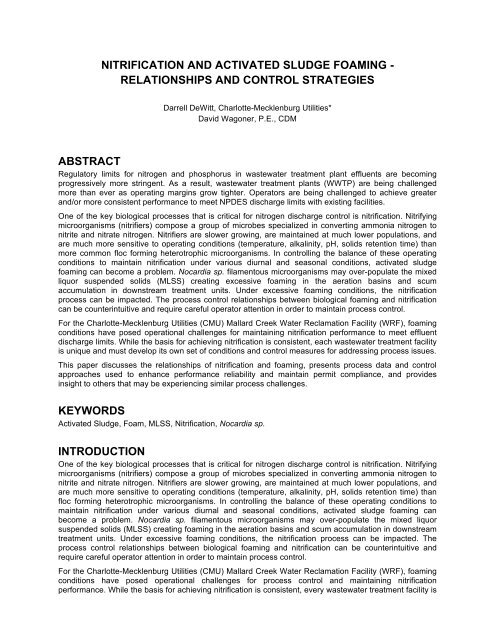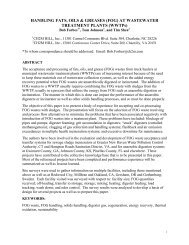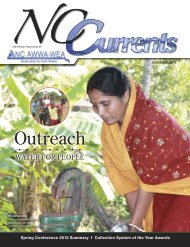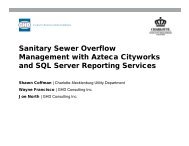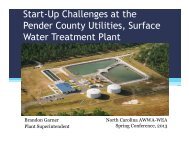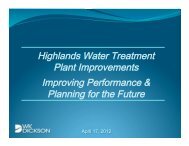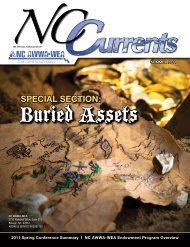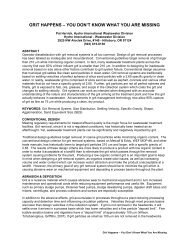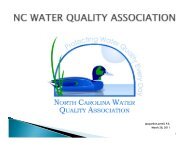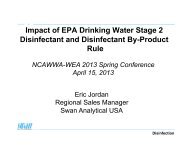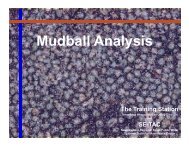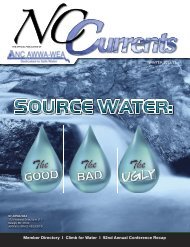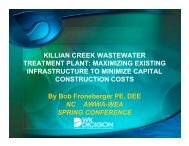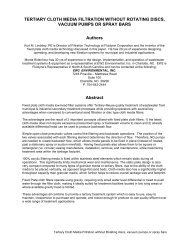NITRIFICATION AND ACTIVATED SLUDGE FOAMING ...
NITRIFICATION AND ACTIVATED SLUDGE FOAMING ...
NITRIFICATION AND ACTIVATED SLUDGE FOAMING ...
You also want an ePaper? Increase the reach of your titles
YUMPU automatically turns print PDFs into web optimized ePapers that Google loves.
<strong>NITRIFICATION</strong> <strong>AND</strong> <strong>ACTIVATED</strong> <strong>SLUDGE</strong> <strong>FOAMING</strong> -<br />
RELATIONSHIPS <strong>AND</strong> CONTROL STRATEGIES<br />
Darrell DeWitt, Charlotte-Mecklenburg Utilities*<br />
David Wagoner, P.E., CDM<br />
ABSTRACT<br />
Regulatory limits for nitrogen and phosphorus in wastewater treatment plant effluents are becoming<br />
progressively more stringent. As a result, wastewater treatment plants (WWTP) are being challenged<br />
more than ever as operating margins grow tighter. Operators are being challenged to achieve greater<br />
and/or more consistent performance to meet NPDES discharge limits with existing facilities.<br />
One of the key biological processes that is critical for nitrogen discharge control is nitrification. Nitrifying<br />
microorganisms (nitrifiers) compose a group of microbes specialized in converting ammonia nitrogen to<br />
nitrite and nitrate nitrogen. Nitrifiers are slower growing, are maintained at much lower populations, and<br />
are much more sensitive to operating conditions (temperature, alkalinity, pH, solids retention time) than<br />
more common floc forming heterotrophic microorganisms. In controlling the balance of these operating<br />
conditions to maintain nitrification under various diurnal and seasonal conditions, activated sludge<br />
foaming can become a problem. Nocardia sp. filamentous microorganisms may over-populate the mixed<br />
liquor suspended solids (MLSS) creating excessive foaming in the aeration basins and scum<br />
accumulation in downstream treatment units. Under excessive foaming conditions, the nitrification<br />
process can be impacted. The process control relationships between biological foaming and nitrification<br />
can be counterintuitive and require careful operator attention in order to maintain process control.<br />
For the Charlotte-Mecklenburg Utilities (CMU) Mallard Creek Water Reclamation Facility (WRF), foaming<br />
conditions have posed operational challenges for maintaining nitrification performance to meet effluent<br />
discharge limits. While the basis for achieving nitrification is consistent, each wastewater treatment facility<br />
is unique and must develop its own set of conditions and control measures for addressing process issues.<br />
This paper discusses the relationships of nitrification and foaming, presents process data and control<br />
approaches used to enhance performance reliability and maintain permit compliance, and provides<br />
insight to others that may be experiencing similar process challenges.<br />
KEYWORDS<br />
Activated Sludge, Foam, MLSS, Nitrification, Nocardia sp.<br />
INTRODUCTION<br />
One of the key biological processes that is critical for nitrogen discharge control is nitrification. Nitrifying<br />
microorganisms (nitrifiers) compose a group of microbes specialized in converting ammonia nitrogen to<br />
nitrite and nitrate nitrogen. Nitrifiers are slower growing, are maintained at much lower populations, and<br />
are much more sensitive to operating conditions (temperature, alkalinity, pH, solids retention time) than<br />
floc forming heterotrophic microorganisms. In controlling the balance of these operating conditions to<br />
maintain nitrification under various diurnal and seasonal conditions, activated sludge foaming can<br />
become a problem. Nocardia sp. filamentous microorganisms may over-populate the mixed liquor<br />
suspended solids (MLSS) creating foaming in the aeration basins and scum accumulation in downstream<br />
treatment units. Under excessive foaming conditions, the nitrification process can be impacted. The<br />
process control relationships between biological foaming and nitrification can be counterintuitive and<br />
require careful operator attention in order to maintain process control.<br />
For the Charlotte-Mecklenburg Utilities (CMU) Mallard Creek Water Reclamation Facility (WRF), foaming<br />
conditions have posed operational challenges for process control and maintaining nitrification<br />
performance. While the basis for achieving nitrification is consistent, every wastewater treatment facility is
unique and must develop its own set of conditions and control measures for addressing relative process<br />
issues. The work effort described and the resulting information presented in this paper is part of a<br />
program to promote continuous improvement at the WRF - a key initiative throughout CMU.<br />
The WRF treatment system includes flow equalization, primary clarifiers, Modified Ludzack-Ettinger<br />
(MLE) activated sludge system, tertiary sand filters, and anaerobic digesters. Historically, the WRF has<br />
had issues with foaming conditions which caused issues in the aeration basins and in downstream unit<br />
processes - conveyance foaming, secondary clarifier excessive scum, excessive blinding of final filters,<br />
and impacts to water reuse program. Figures 1 and 2 present typical nocardial foam and scum<br />
conditions.<br />
Figure 1 – Nocardial foam on aeration basin surface<br />
Figure 2 – Nocardial scum on secondary clarifier surface<br />
Compliance with ammonia nitrogen limits is challenged at times by periodic ammonia pass-through of the<br />
aeration basins particularly during winter operating conditions.<br />
This paper discusses the relationships of nitrification and foaming, presents the results of process data<br />
evaluations, presents control approaches used to control foaming and to enhance nitrification reliability<br />
and overall plant operations, and provides insight to others that may be experiencing similar process<br />
challenges.
METHODOLOGY<br />
An integrated, hands-on operations approach was used to evaluate the issues of foaming and nitrification<br />
performance at the WRF. The steps included:<br />
• Defining the situation at the facility with regard to foaming and nitrification issues<br />
• Understanding background information - assimilating process data and information resources<br />
• Assessing the information, and<br />
• Developing recommendations to address the issues<br />
Background data used for the evaluation were historical operations and process data from operator<br />
sampling, and archived and real-time data from SCADA via on-line analyzers. Key on-line monitoring<br />
includes ammonia, pH and dissolved oxygen (DO). As the evaluation program progressed, additional online<br />
analyzers for ammonia (primary effluent and aeration basins) and TSS (aeration basins and<br />
secondary effluent) were installed for process/performance monitoring and data trending. To fully<br />
understand the components of the foam to help establish the root causes, microscopic analyses of MLSS<br />
and foam were conducted.<br />
The initial review of historical data from periods of ammonia pass-through of the aeration basins was<br />
somewhat puzzling as no critical process factors seemed to be askew – DO, MLSS/MCRT, alkalinity, and<br />
temperature all appeared to be in good range for providing complete nitrification based on the flows and<br />
loading conditions to the WRF. Short circuiting through the aeration basins was not a factor. From this<br />
review, sample collection points were examined and additional MLSS sampling points along with<br />
additional auto samplers for TSS (MLSS) were implemented to help with understanding the MLSS<br />
concentration and profiles in the aeration basins and in aeration basin effluent. Grab samples from the<br />
aeration basin were collected and analyzed for ammonia nitrogen to develop a nitrification profile along<br />
the length of the aeration basins. From this work, additional ammonia on-line analyzers were installed to<br />
track ammonia levels in the influent to and through the aeration basins, see Figure 3.<br />
Figure 3 – On-line ammonia analyzer for secondary influent monitoring<br />
RESULTS<br />
The microscopic analyses of the MLSS and associated foam identified Nocardia sp. bacteria as the<br />
agents promoting the foaming conditions. Figure 4 presents an example micrograph of Nocardia sp.<br />
bacteria. Nocardial filaments cause foaming due to their hydrophobic nature. Their growth is promoted by<br />
several conditions generally in combination including elevated mean cell residence time (MCRT), higher<br />
levels of fats/oils/grease/fatty acids in the wastestream, acidic range pH levels, and foam trapping
conditions. Excessive nocardial growth creates a persistent foam and scum conditions in treatment units<br />
which can overcome the handling capacity for treatment systems. Foam on the aeration basins contains<br />
the same organisms as in the MLSS except in more concentrated form. Activated sludge bacteria residing<br />
in the foam are removed from the active mixture and not as available as those bacteria within the<br />
liquid/mixed MLSS for stabilization of the wastewater constituents including ammonia nitrogen.<br />
Figure 4 – Nocardial filaments<br />
Evaluation of MLSS data initially from grab samples and later from online analyzers indicated that there<br />
was significant variability in MLSS concentrations across the length aeration basins, the severity of which<br />
was dependent upon the severity of foaming conditions. The MLSS profile data indicated a progressive<br />
decline in the liquid concentration of solids in the MLSS in the aeration basins (samples collected from the<br />
liquid beneath the foam layer). This liquid MLSS concentration was given the term “effective MLSS” as it<br />
represents the MLSS that is most actively engaged in the aeration basin mixture. The term “total MLSS”<br />
was given to the mixture of liquid and foam. Samples of this mixture was historically collected<br />
downstream of the aeration basins and used for process control decisions. Figure 5 presents an example<br />
of a trend of the change in Total and Effective MLSS as foaming conditions increase.<br />
Figure 5 – Total Vs Effective MLSS Trend with Increasing Foaming<br />
The ammonia nitrogen data from the aeration basin profiles indicated that incomplete nitrification is linked<br />
to elevated foaming conditions causing lower effective MLSS concentrations.
DISCUSSION<br />
Nocardia sp. is a type of branched filamentous bacteria that is part of the population of microorganisms in<br />
a healthy activated sludge system. However, excessive/disproportionate nocardial levels will lead to<br />
increasing levels of foaming and scum production. To help minimize foaming in systems that are prone to<br />
Nocardia, aeration systems should be carefully controlled so over-aeration does not occur. Excessive<br />
aeration creates excessive foaming in elevated Nocardia conditions. The WRF has installed automated<br />
DO control systems that help to minimize excessive aeration conditions. Key food sources for Nocardia<br />
are fats/oils/grease and fatty acids. Limiting these foods will help to control nocardial populations.<br />
Maintaining a near neutral pH in the aeration system is also a benefit to help control Nocardia and to<br />
support nitrification performance. MCRT perhaps is the most important process parameter for Nocardia<br />
control and for nitrification performance. Generally, nitrifiers require an older sludge or higher MCRT.<br />
However, higher MCRT levels will promote Nocardia growth. Herein rests the critical balance -<br />
maintaining high enough MCRT to support nitrification performance and low enough MCRT to minimize<br />
Nocardia growth.<br />
For the WRF, the MCRT operating range to control this balance is very narrow and presents a challenge<br />
to maintain adequate MCRT to achieve complete nitrification while controlling foaming. Historically,<br />
winter operations have presented the greatest challenge. During winter operations when nitrification rates<br />
decrease due to lower aeration basin temperatures, to maintain adequate nitrification performance, the<br />
MCRT generally needs to be raised in the effort to increase the population of nitrifiers in the MLSS. In<br />
this effort, WAS is systematically reduced to raise the MLSS (increases MCRT). However, in systems<br />
prone to nocardial foaming this increase in MCRT can lead to negative results. The increasing MCRT<br />
promotes Nocardia, increases foaming, decreases effective MLSS, and decreases active nitrifiers<br />
resulting in diminished nitrification performance. When nitrification performance starts to decrease, the<br />
normal impulse is to preserve/build nitrifiers by reducing wasting. However, this creates more selective<br />
forces for increasing Nocardia which creates further detrimental conditions for nitrification. Figure 6<br />
presents a chronological plot showing the impact of decreasing wasting, increasing foaming, drop in<br />
effective MLSS, and decrease in nitrification performance.<br />
Figure 6 – Chronological Plot of Effective and Total MLSS, and Nitrification with Decreasing WAS<br />
Additionally, even as temperatures increased during this period, nitrification performance did not improve.<br />
Given the understanding of these relationships, the WRF instituted careful controls for MCRT, aeration<br />
intensity, and alkalinity/pH to minimize Nocardia foam and scum in order to maintain more consistent
nitrification performance. The WRF performance has become more consistent and with experience, the<br />
plant staff has become keenly aware of how quickly the system can react to changes in WAS to promote<br />
foam and scum increases.<br />
Given this sensitivity which has been seen to be more pronounced in winter operations, additional means<br />
to help reduce ammonia nitrogen pass-through during periods of higher foaming conditions were<br />
investigated. Data from the on-line ammonia analyzer monitoring secondary influent provided information<br />
that ammonia nitrogen concentrations in the influent after flow equalization varied significantly during a 24<br />
hour period. Historically, the WRF has operated on the basis of equalized diurnal flow. This system is<br />
automated through SCADA programming for control of flow equalization basins and pumping systems.<br />
With the ammonia nitrogen concentration variability, a constant flow approach created a wide range of<br />
actual ammonia nitrogen loading to the activated sludge system. Using the SCADA system, online<br />
ammonia analyzer, and existing equalization system capabilities, an ammonia nitrogen load control<br />
system was developed. Figure 7 provides a screen shot of the nitrogen load control “switch” which is now<br />
used to target the ammonia load to the activated sludge system.<br />
Figure 7 – SCADA load control screen shot<br />
The ammonia loading control switch is located near the center of screen. As shown, the targeted<br />
ammonia loading rate is 2,600 lb/day. The switch window also includes the actual current loading value.<br />
Implementation of this control system to enable more equalized ammonia nitrogen loading provided<br />
immediate positive impact to the WRF including:<br />
• Reduced MCRT required to achieve nitrification (no need to maintain higher MCRT for the higher<br />
loading periods)<br />
• Reduced/eliminated nocardial foaming and scum – minimal Effective and Total MLSS differential<br />
• Stable aeration system demands - more consistent loading creates aeration supply consistency<br />
and lower peak power requirements; lower aeration intensity – lower foaming tendencies<br />
• Stable alkalinity demands<br />
• Stable anoxic selector operation
• Reduced scum on secondary clarifiers and improved clarifier performance<br />
• Improved final filter performance and reduced backwashing<br />
Figure 8 and 9 present SCADA screen shots of typical conditions before and after the ammonia nitrogen<br />
load control program was implemented.<br />
Figure 8 – Typical flows and load conditions prior to ammonia nitrogen load control<br />
Flow to aeration<br />
Ammonia load<br />
Chart presents the conditions of variable ammonia load with near constant flow. Ammonia loading rate<br />
range under these equalized flow conditions was 1,900 – 4,100 lb/day.<br />
Figure 9 – Typical flows and load conditions after ammonia nitrogen load control<br />
Flow to aeration<br />
Ammonia load
This chart presents an example of targeted consistent ammonia load by variable control of flow rates<br />
relative to varying ammonia nitrogen concentrations. The ammonia loading rate under these conditions<br />
was 1,300 – 2,740 lb/day. Note that the minimum ammonia load value is affected by a dip in flow that<br />
occurs when the flow EQ basins reach minimum low level.<br />
CONCLUSIONS<br />
To date, the WRF evaluation to control foaming and enhance nitrification stability has provided good<br />
insight into the relationships between the variables that are involved in maintaining a balance in the<br />
microbiological community in the WRF. Each wastewater treatment plant is unique and the responses to<br />
process control approaches and adjustments need to be tuned to the specific conditions for each facility.<br />
For this effort, key process data is necessary. On-line analyzers tied into SCADA provide an advantage to<br />
the operations team to make informed process control decisions and to see the responses of the system<br />
to these calculated adjustments.<br />
While great improvements have been realized in the performance of the WRF through this evaluation and<br />
progressive implementation of operational changes and control equipment, the WRF continues to adjust<br />
the operation to optimize conditions. The approaching winter season will provide the first opportunity to<br />
operate using the equalized ammonia nitrogen loading control system. The WRF staff awaits the<br />
challenge of these conditions with greater understanding, more tools and higher confidence that improved<br />
control of Nocardia foam and scum, and more consistent nitrification performance will be achieved.


